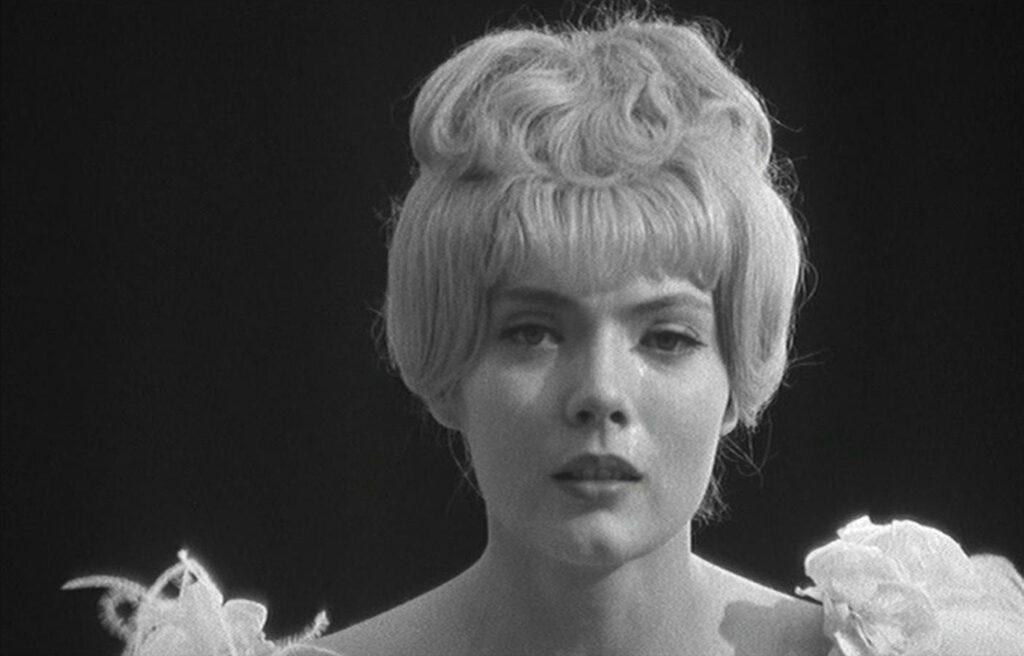
Cléo from 5 to 7
1962, directed by Agnès Varda
An hour into Cléo from 5 to 7, Cléo and Dorothée watch a three-minute silent film from a cinema’s projection booth. As is so often the case, the embedded story tells the story of the whole movie. The short is about a man (played by Jean-Luc Godard) whose point of view turns pessimistic when he puts on dark glasses, but life looks up again when he takes them off. Cléo from 5 to 7 is also about a positive change in outlook, as Cléo goes from worry and superstition to hope and joy.
Cléo’s journey across Paris begins with an ominous visit to a fortune teller, and her mood remains dark through the first hour. The turning point when she figuratively removes her dark glasses happens in the taxi just after the short film, when she gives her new hat to Dorothée. It’s her first real selfless act, and the moment she gives it up her day brightens. There’s a surge of music, and the ride through Paris turns lyrical as the taxi flows through the square and down a tree-lined avenue. A moment later the name of the park ahead, Montsouris, makes her smile. She says saying it is like saying “cheese” for a camera.
The movie however goes beyond good feelings. It’s not merely the story of a transformation, but a story of transformation in general, about how our lives can change for the better. Let us examine the various parallel transformations that occur, in order of increasing impact:
1. Change of mood
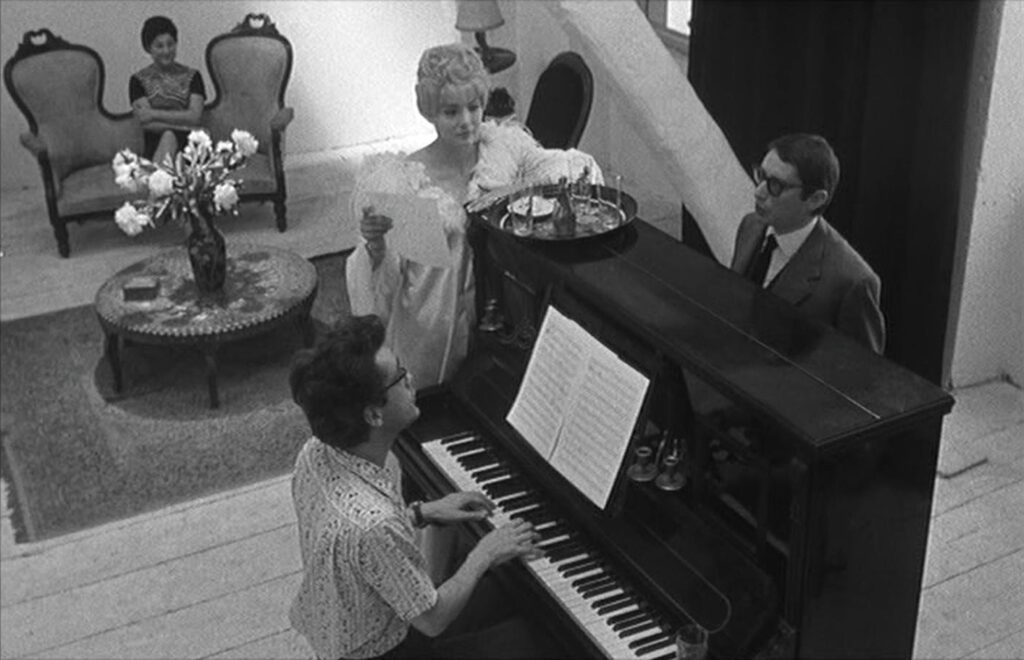
Cléo’s story begins with tarot cards that seem to confirm Cléo’s fear of death. In an hour and a half she’ll speak to her doctor about a suspected cancer diagnosis, and she’s weighted down with anxiety. Between the fortune teller and the hospital she keeps finding omens of death: Angèle’s story in the café, the man who spits out frogs, the pierced bicep, grotesque statues, the murder scene, the lyrics to Cléo’s new song (“My body decays on a crystal bier…. They’ll have laid me to rest ashen, pale, and alone”), Antoine going off to the Algerian War, the coffin-like incubator, a funeral parlor… but most of the omens can also be read as signs of life, and some of them also forecast a reprieve. Her taxi going home stops three times in a row, aligning Cléo’s window each time with masks. Twice in a row, by uncanny coincidence, tribal masks stare out at her from shop windows, then on the third stop student revelers in costume masks surround the taxi. Inanimate omens thus give way to real life, and the movie will follow the same pattern, also measured in thirds. After an hour of mounting worry, Cléo’s spirits rise markedly in the last half hour.
2. Change of thinking
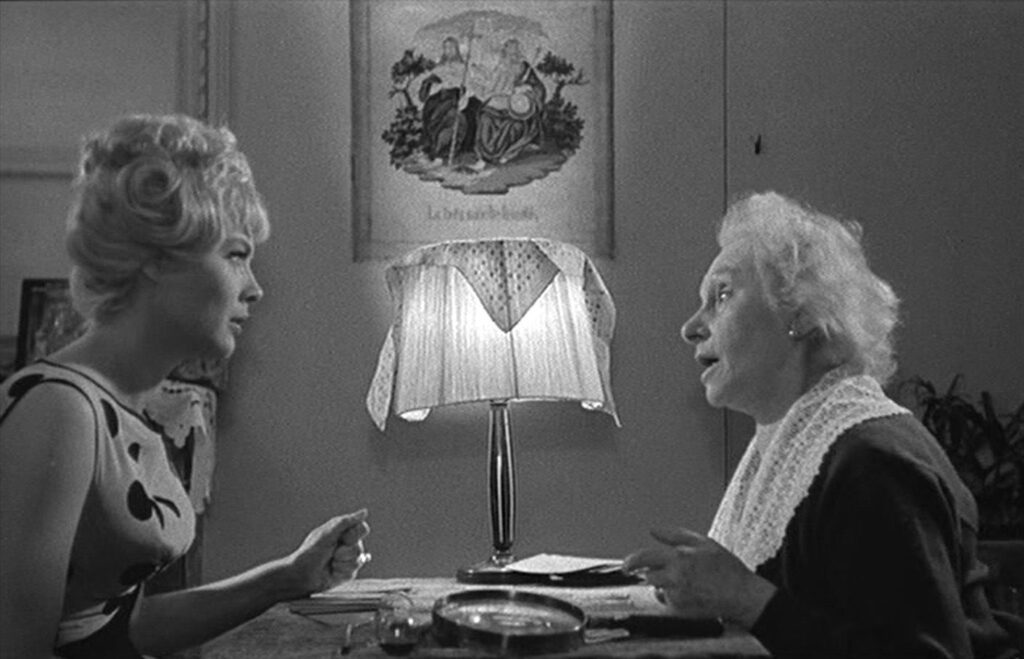
The tarot cards are only the first of many superstitious forebodings: the unlucky taxi number, the hat on the bed, the broken mirror, the dead man. Cléo’s assistant Angèle encourages her superstitions, telling her not to wear new things on a Tuesday; apparently she also recommended the fortune teller, as she knows the woman by name. Dorothée is a more positive influence, deflecting Cléo’s superstition by telling her the broken mirror was for the dead man. By the end these signs have come to nought, and faith in life replaces superstition. It’s significant that the tarot cards, which prove deceptive, are shot in color… there’s a common belief that color is truer than black & white, but verisimilitude does not equal truth. A black and white film, because it does not pretend to reproduce exact reality, challenges the viewer to test its connection to reality, and thus has an advantage in honesty. The further Cléo gets from the tarot cards and her other superstitions, the closer she comes to perceiving the world around her.
3. Change of character
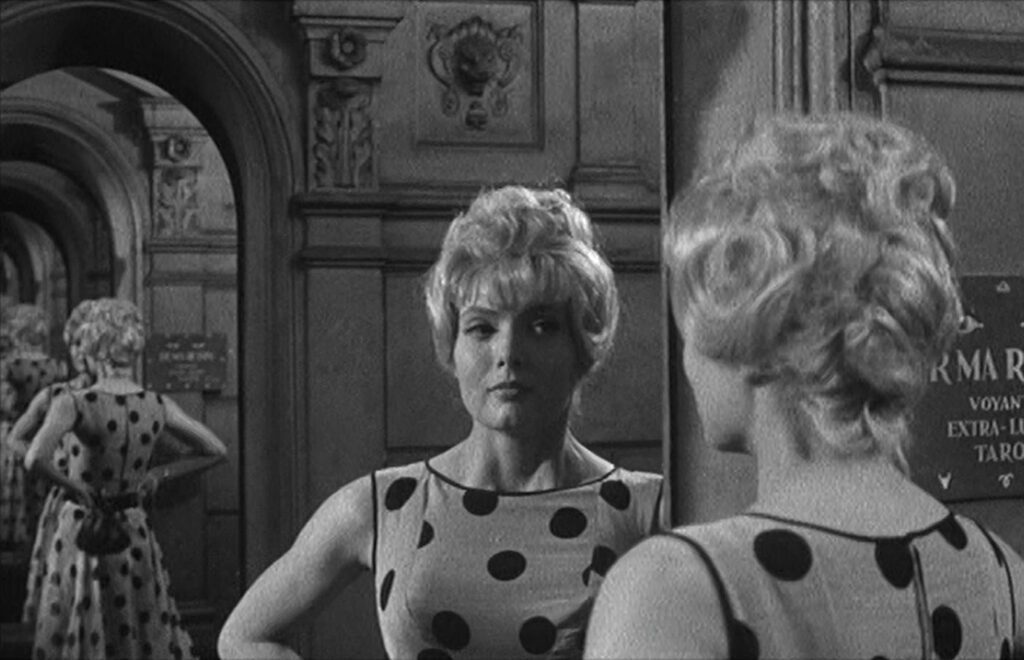
Right after leaving the fortune teller, Cléo stands at a double mirror and reassures herself that as long as she’s beautiful she’s alive. She’s a successful pop singer, and her fans and hangers-on feed her vanity. A few minutes later she poses coquettishly in a series of chic hats, drawing compliments from the shopkeeper, who is honored once she learns Cléo’s identity. She’s self-conscious hearing her own voice on the taxi radio, but later she plays the same song on a café jukebox just to watch people’s reactions. Her vanity is so extreme that she’s glad the prospective cancer is in her stomach where it’s not visible. Superstition is also a kind of vanity, an idea that the world revolves around oneself. The antidote to Cléo’s vanity is Dorothée, a model who poses nude for artists. Dorothée says, “My body makes me happy, not proud.” When Cléo’s mirror shatters, the broken symbol of vanity makes space for Cléo to live with herself in a new way.
4. Change of action
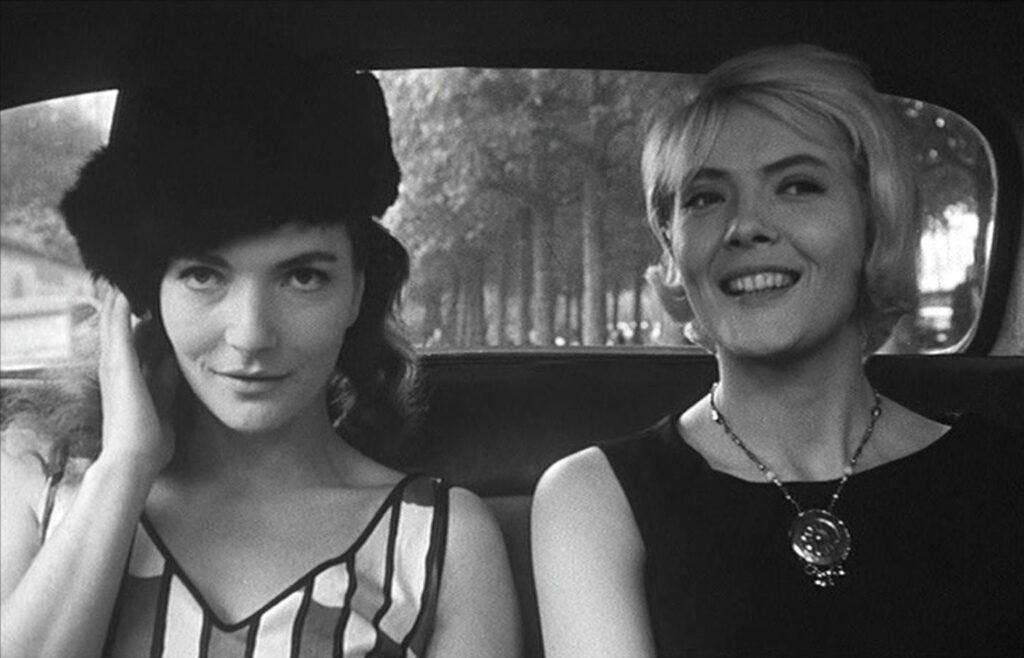
In the café after the fortune teller, Angèle tells the proprietor about a sick man in her village whose doctor said he would die. The man gets out of bed and immediately travels around the world. When he comes home his wife is dead, but he lives a long and healthy life. Like that man, Cléo starts out passive, nervously hoping for good news from her doctor. The fortune teller and Angèle both encourage Cléo’s passivity; one puts her life in the hands of fate, while the other caters to her and flatters her. Even her songwriter friends cast her as passive – her new song “Cry of Love” is about depending on a man. Counteracting these bad influences, Cléo encounters a progression of brave and independent women: a woman in the café (whose conversation overlaps Angèle’s story) who refuses to sleep with her boyfriend; the taxi driver who fearlessly chases down deadbeat customers at night; and finally Dorothée, whose spirit of freedom is so much greater than Cléo’s. When Cléo gives Dorothée the black hat, for once she overcomes her passivity and does something for someone else.
5. Metaphysical change
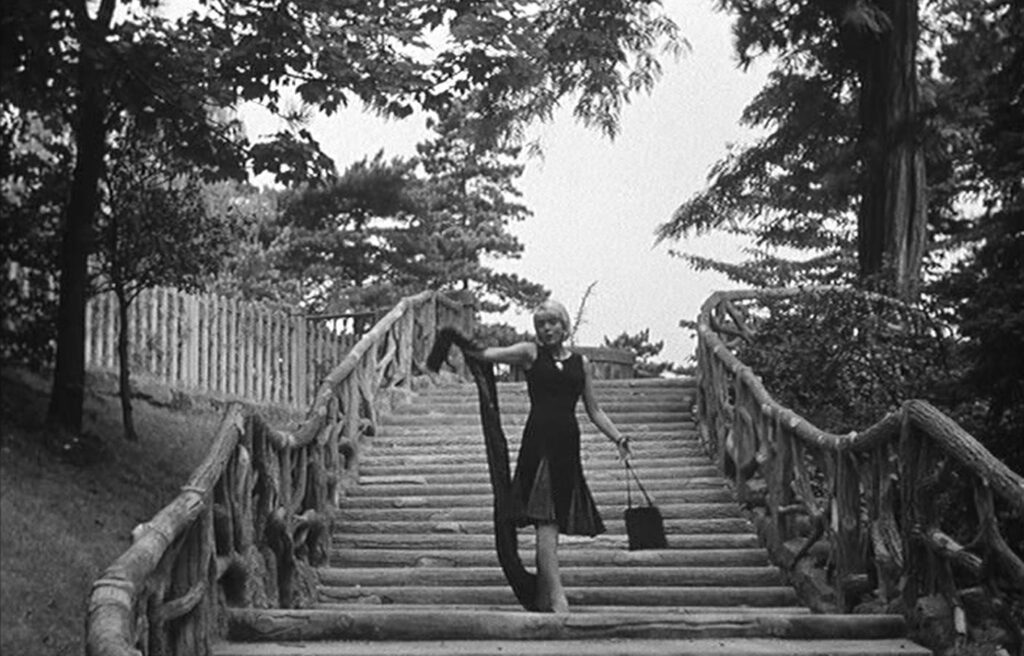
Like a few other great films, the protagonist’s transformation comes with a new idea of time. The title refers to time (the story actually runs only until 6:30 p.m.), and the movie takes place on the summer solstice, a reminder of calendar time. Cléo starts out plodding through time, wishing to fast-forward to her diagnosis. By going to a fortune teller she tries to bring the future closer. She’s not living in the present but in some abstract and tedious linear time. Going down the fortune teller’s stairway the music echoes her clicking footsteps like a clock ticking away the seconds. A shot of her descending a step repeats three times in quick succession as if her existence were lifeless and mechanical. The movie is filled with clocks, and the section headings mark the passing minutes conspicuously. When the feeling becomes too oppressive she walks around Montparnasse, but memories and forebodings keep flashing through her mind. She’s been surrounded by friends, happiness, and the beauty of Paris, but until she gives up her hat she’s not capable of living in the moment. Time itself changes for her in the last scenes; the tick-tock of her footsteps in Parc Montsouris is drowned out by birds singing and the murmur of the waterfall. She remarks to the cab driver that the Moorish revival observatory reminds her of the 1001 Nights, the stories Scheherazade told in order to live day by day until she was free to live without fear. At the end Cléo too is freed from her fear and ready to appreciate life.
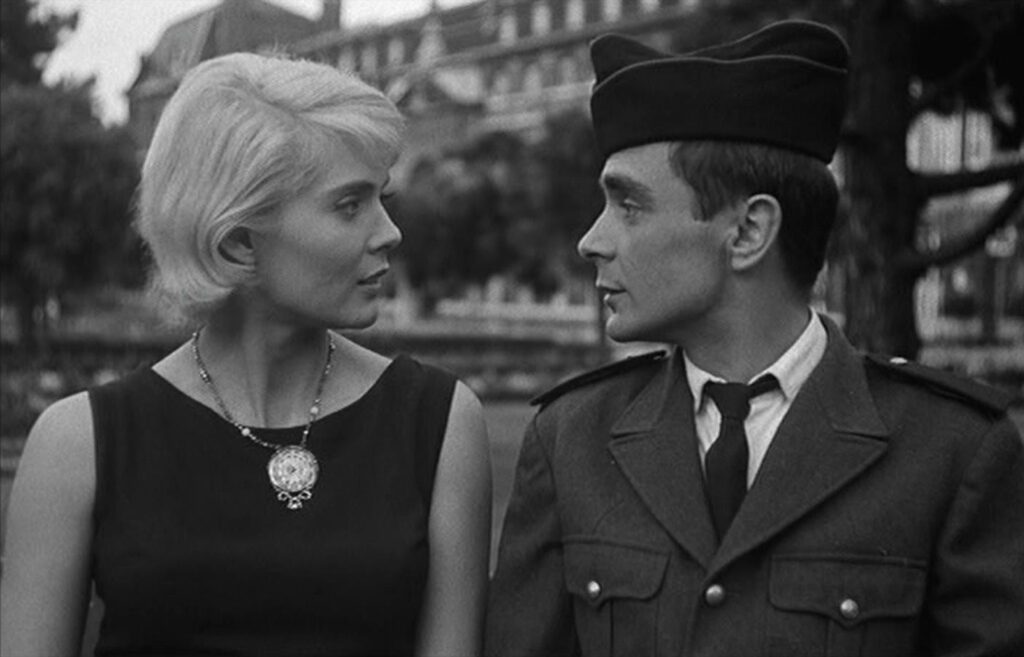
All of these transformations go hand in hand, and they’re all united in the moment when Cléo gives away her hat. In that instant her mood brightens, she sheds an object of superstition, she gives up something she purchased out of vanity, she does something for someone else, and she’s now able to live in the moment. The hat, after all, was not appropriate for the present season. “It’s not even a summer hat,” Cléo tells Dorothée, who replies, “All winter I wanted one like that.”
In all these ways Cléo from 5 to 7 demonstrates the changes a person can make in a single day, even within a couple of hours. Of course that sounds incredible, and the film plays with the believability of its premise. As if a day seemed too short to hold so much change, the film is set on the longest day of the year, and Cléo’s journey too is comically unbelievable. Try tracing her path from the Right Bank to Montparnasse to Parc Montsouris to the Pitié-Salpêtrière Hospital during rush hour in 90 minutes, even without stopping to visit a fortune teller, dine at a café, shop for a hat, unwind at home, receive visitors, visit a sculptor’s studio, watch a short film in a cinema, and make a new friend. We can laugh at the implausible journey, but if Cléo’s transformation is too much to believe we should remind ourselves that in normal life these changes are a constant process that needs to be renewed continuously.
CONNECTIONS:
Vampyr – Protagonist transforms from passive to active upon giving something (blood/hat) away
Shadow of a Doubt – Feeling of the story changes when an object (ring/hat) changes hands
Ugetsu monogatari – Begins with linear time, ends with timelessness
Wild Strawberries – Turning point where a character changes in multiple ways
The Eighth Day of the Week – Story of despair turning to hope; journey through a city; scene where numerous people on the street stare at a woman; brief color; line about glasses
Les bonnes femmes – Film counts down the minutes to illustrate the oppressiveness of clock time; feminist point of view; Paris setting within a clearly defined span of time
La notte – Past, present, and future represented in a walk through city
Run Lola Run – Arc from fear of time to faith in life, from passivity to involvement; seconds ticking away at the beginning; improbable journey through a European capital with time constraints; frequent interruptions and reminders of passing time
The Day He Arrives – Turning point when the protagonist finally acts selflessly and sheds vanity